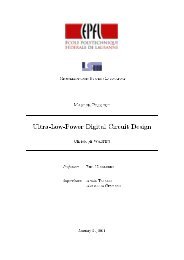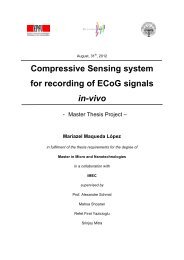"Linear Equation Solver using CMOS Technology" - Microelectronic ...
"Linear Equation Solver using CMOS Technology" - Microelectronic ...
"Linear Equation Solver using CMOS Technology" - Microelectronic ...
Create successful ePaper yourself
Turn your PDF publications into a flip-book with our unique Google optimized e-Paper software.
2 Overview of the Digital <strong>Linear</strong> <strong>Equation</strong> <strong>Solver</strong> HardwareThe proposed digital solver hardware is capable of solving the linear systems of equations with thefollowing properties: Given a matrix A and a vector b, determine x such that Ax = b with a ij , b i , x i in Z 2 A is a quadratic n×n matrix (n ≤ 64), b and x have n coefficients The linear systems of equations with Ax = b have a non-trivial solution All diagonal elements of A are 1.It utilizes feedback loops to settle down to the solution in a considerably short time. Therefore, unlikethe usual solvers that first compute the inverse of the matrix A -1 and multiply by b, the solution x isdetermined in an iterative fashion. Since input matrix A is invertible, feedback of the outputs togetherwith the input matrices A and b force the circuit to a stable state which is in fact the solution x. Itwill "instantly" solve for x iteratively depending on the input matrices without computing theintermediate values like A -1 or the algorithm specific variables for solving the matrices. This providesa considerable speedup for solving a particular system.Since the proposed solver hardware is intended to be used for a practical application in cryptanalysis,a live A5/1 attack, it is supposed to solve the systems with ≤ 64 unknowns in Z 2 . Hence, the goal is todevise a generic way of designing such solvers with feedback that can operate on the quadratic n×nmatrices (n ≤ 64). In this context, first the linear solver is implemented in small scale (for the systemwith 4 unknowns) to characterize the overall performance and performing the stability analysis. Asfurther simulations reveal, the systematic way devised for the small scale system can be extended tolarger scales with a reasonable complexity.Another important remark regarding the design process is that the small scale hardware is firstimplemented in VHDL and the correct operation for all cases is verified by the logic simulation. Later,it is implemented in Cadence environment, and transistor level simulations are performed for moreprecise results.10















